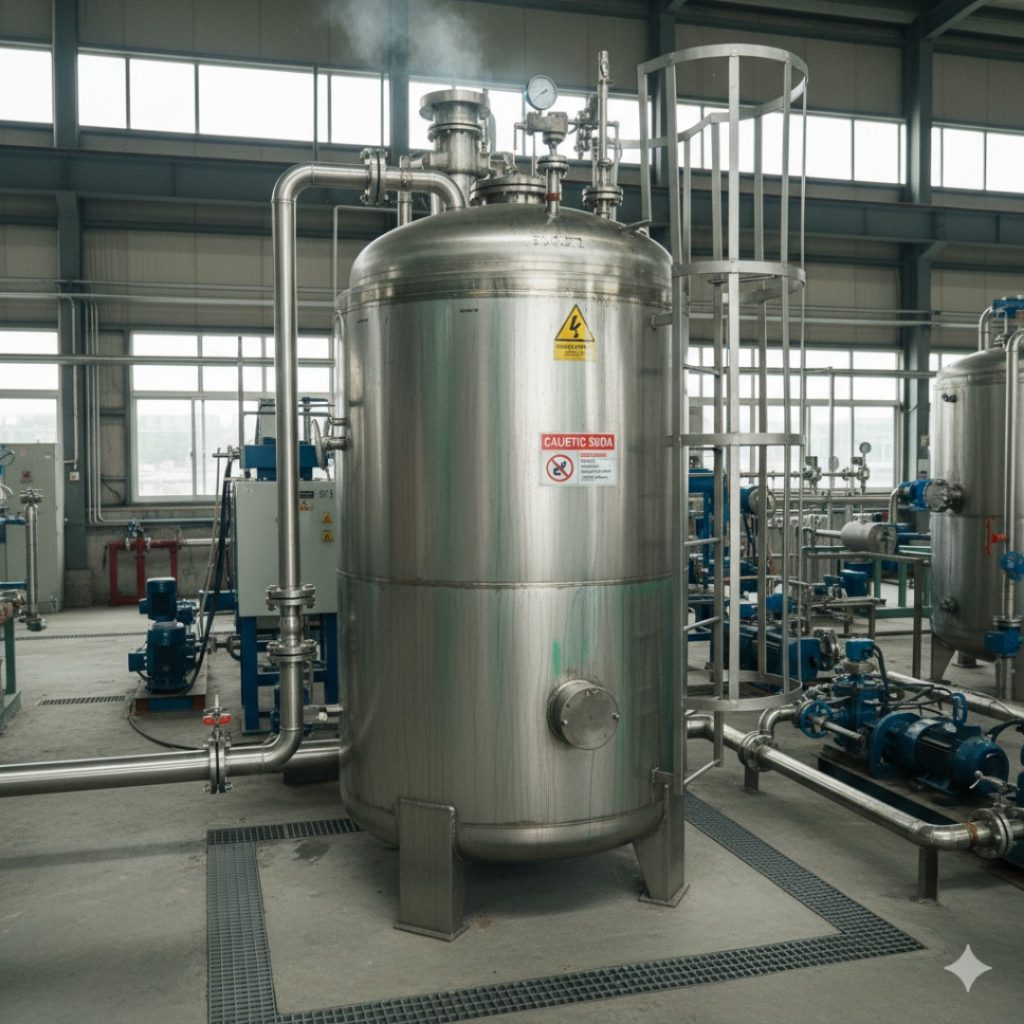Kostik, kimya sektörünün en agresif bileşenlerinden biridir. Özellikle sodyum hidroksit (NaOH) olarak bilinen bu madde; temizlik ürünleri, kağıt sanayi ve su arıtma gibi birçok alanda yaygın olarak kullanılır. Ancak kostik maddeyi güvenli ve uzun süreli depolamak ciddi mühendislik ister. İşte bu noktada paslanmaz kostik tankları devreye girer.
Paslanmaz Kostik Tankı Nedir?
Paslanmaz kostik tankı, aşındırıcı kimyasalları güvenli şekilde depolamak için özel olarak tasarlanmış, genellikle AISI 304 veya 316 kalite paslanmaz çelikten üretilen endüstriyel tanklardır. Bu tanklar hem kimyasal dayanıklılık hem de uzun ömür sunar. Standart tanklardan farkı; daha kalın cidar yapısı, yüksek asit-baz direnci ve özel contalı donanımlarıdır.
Kullanım Alanları
Kimya Sanayi
Kostik madde, kimyasal üretimlerde çözücü ve baz olarak sıklıkla kullanılır. Paslanmaz tanklar bu maddeleri güvenli şekilde depolar.
Gıda Sektörü
Gıda üretiminde temizlikte kullanılan kostik, hijyen standartları yüksek tanklarda saklanmalıdır.
Temizlik Ürünleri Üretimi
Ev tipi ve endüstriyel temizlik ürünlerinin hammaddesi olan kostik, uygun koşullarda depolanmadığında risk oluşturur.
Arıtma Tesisleri
Atık su arıtımında pH dengeleme işlemlerinde kostik kullanılmakta; paslanmaz tanklar bu işlemlerde güvenli çözümler sunmaktadır.
Neden Paslanmaz Malzeme Tercih Edilir?
Korozyona Dayanıklılık
Paslanmaz çelik, kostik gibi agresif maddelere karşı yüksek direnç gösterir.
Uzun Ömür ve Hijyen
Bakteri tutmayan yapısı sayesinde hijyeniktir ve uzun süre kullanılabilir.
Kolay Temizlik ve Bakım
Düz yüzeyli iç yapısı sayesinde temizliği kolaydır. CIP sistemleriyle de uyumludur.
Paslanmaz Kostik Tanklarının Teknik Özellikleri
AISI 304 / 316 Kalite Farkı
304 kalite, genel kimyasallarda yeterliyken; 316 kalite, daha yoğun ve tehlikeli kimyasallar için idealdir.
Cidarlı ve Isıtıcılı Yapılar
Tank içerisine ısıtma ya da soğutma sağlamak için cidarlı modeller tercih edilir.
Karıştırıcı Sistemler
Yoğunluğu yüksek sıvılar için karıştırıcı sistemlerle homojenlik sağlanır.
Seviye Göstergesi ve Emniyet Sistemleri
Tank içeriği, seviye sensörleri ve basınç emniyet valfleriyle güvenli şekilde kontrol altına alınır.
Asinoks Farkıyla Üretilen Kostik Tankları
Özel Üretim ve Mühendislik
Asinoks, her ihtiyaca özel ölçü ve teknik özelliklerde tank üretimi gerçekleştirir.
Talebe Özel Ölçü ve Donanım
İşletmenizin kapasitesine ve ihtiyacına özel projelendirme yapılır.
Kalite Kontrol Süreçleri
Her ürün, sevkiyattan önce sızdırmazlık ve dayanıklılık testlerinden geçer.
Paslanmaz Kostik Tankı Seçerken Nelere Dikkat Edilmeli?
Hammaddeye Uygunluk
Depolanacak kostik maddeye göre çelik kalitesi belirlenmelidir.
Kapasite İhtiyacı
İşletme hacmi ve tüketim miktarına göre doğru hacim seçilmelidir.
İşletme Ortamı Koşulları
Tankın kullanılacağı alanın sıcaklık, nem ve ortam riskleri göz önüne alınmalıdır.
Sertifikasyon ve Standartlar
CE, ISO gibi belgelerle kalite güvence altına alınmalıdır.
CIP Temizlik Sistemine Uyum
CIP (Clean In Place) sistemine uyumlu tanklar, üretim durmadan içten yıkama sağlar. Bu da hem hijyen hem de zaman tasarrufu anlamına gelir.
Depolama ve Güvenlik Önlemleri
Asit ve Baz Güvenliği
Kostik maddelerin oluşturduğu tehlikeler için özel sızdırmazlık ve havalandırma sistemleri bulunmalıdır.
Patlama, Sızıntı ve Taşma Riskleri
Sensör destekli kontrol sistemleriyle bu riskler minimuma indirilir.
Enerji Verimliliği ve Çevresel Etkiler
İzolasyonlu Yapıların Katkısı
Isı kaybını önleyerek enerji maliyetini düşürür.
Geri Dönüşümle Sürdürülebilirlik
Paslanmaz çelik tamamen geri dönüştürülebilir, çevre dostudur.
Maliyet ve Yatırım Geri Dönüşü
İlk Yatırım ve Uzun Vadeli Kazanç
Başlangıç maliyeti yüksek gibi görünse de uzun ömrü sayesinde amortisman süresi kısadır.
Bakım ve Servis Avantajları
Asinoks’un teknik servis ağı sayesinde minimum arıza ve hızlı müdahale avantajı sağlar.
Sonuç
Paslanmaz kostik tankları, kimyasal maddelerin güvenli ve hijyenik bir şekilde depolanması için vazgeçilmez çözümler sunar. Asinoks olarak, sektördeki deneyimimizle işletmenizin ihtiyaçlarına özel, güvenli ve dayanıklı kostik tankları üretiyoruz. Kaliteli üretim, teknik destek ve mühendislik çözümleriyle Asinoks her zaman yanınızda!
Sıkça Sorulan Sorular (FAQ)
- Paslanmaz kostik tankı ne kadar süre kullanılabilir?
Doğru bakım ile 20 yıla kadar kullanılabilir. - CIP sistemine uygun tankların avantajı nedir?
Üretimi durdurmadan hijyen sağlar, iş gücünden tasarruf ettirir. - 304 ile 316 kalite paslanmaz arasında ne fark var?
316 kalite, daha agresif kimyasallara karşı daha dayanıklıdır. - Tanklar özelleştirilebilir mi?
Evet, Asinoks her ihtiyaca özel ölçü ve teknik donanım sunar. - Tank bakımı nasıl yapılır?
Periyodik temizlik, conta kontrolü ve seviye sensörü testleriyle kolayca sağlanır.


